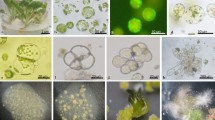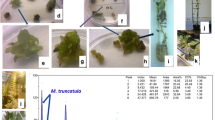Summary
Leaves and stems from endod (Phytolacca dodecandra L'Herit), known to produce the 29 kDa ribosome-inactivating protein (RIP) dodecandrin, were initiated into tissue culture. Callus and suspension cultures were maintained on modified Murashige and Skoog medium plus 1.0 mg/l 2,4-dichlorophenoxyacetic acid. Six callus and two suspension cell lines were screened for dodecandrin production by western blots with affinitypurified antiserum. Antiribosomal activity of culture extracts was tested by in vitro translation assays. One suspension cell line was found to be free of immunoreactive proteins and a ribosome inhibitor. All other cell lines contain a ribosome inhibitor, although only two callus cell lines show detectable amounts of immunoreactive proteins at the same Mr as dodecandrin. Other immuno-reactive proteins were detected in callus (Mr 31000, 33000, 41000 and 43000) and in suspension cells (Mr 23000 and ∼43000), and may be ribosome inhibitors related to dodecandrin—either other RIPs or dodecandrin at various stages of processing.
Similar content being viewed by others
References
Adams RP, Balandrin MF (1984) In: Lemma A, Heyneman D, Silangwa S (eds) Phytolacca dodecandra (Endod); Final Report of the International Scientific Workshop, Lusaka, Zambia. March 1983. Tycooly International, Dublin, pp133–137
Barbieri L, Bolognesi A, Cenini P, Falasca AI, Minghetti A, Garofano L, Guicciardi A, Lappi D, Miller SP, Stirpe F (1989) Biochem. J. 257:801–807
Bradford MM (1976) Anal. Bioch. 72:248–254.
Chi HJ, Kim HS (1985) Arch. Pharmacal. Res. (Seoul) 8:15–20. in Chem. Abstr. 80–70566
Drobniewski FA (1989) Biosc. Rep. 9:139–156
Endo Y, Mitsui K, Motizuki M, Tsurugi K (1987) J. Biol. Chem. 262:5908–5912
Endo Y, Tsurugi K, Lambert JM (1988) Bioch. Bioph. Res. Comm. 150:1032–1036
Ervin SE, Preston JF III (1980) J. Cell. Biol. 107:389a
Frankel AE, Houston LL, Issell BF (1986) Annu. Rev. Med 37:125–142
Gendron Y, Kassanis B (1954) Annal. Appl. Biol. 41:183–188
Ikeda T, Takanami Y, Imaizumi S, Matsumoto T, Mikami Y, Kubo S (1987) Plant Cell Rep. 6:216–218
Irvin JD (1983) Pharmac. Ther. 21:371–387
Irvin JD, Kelly T, Robertus JD (1980) Arch. Bioch. Biophys. 200:418–425.
Kernan NA, Byers V, Scannon PJ, Mischak RP, Brochstein J, Flomenberg N, Dupont B, O'Reilly RJ (1988) JAMA 259:3154–3157
Kloos H (1979) In: Lemma A, Heyneman D, Kloos H (eds) Studies on the Molluscicidal and Other Properties of the Endod Plant, Phytolacca dodecandra. University of California, San Francisco, pp 20–38
Laemmli UK (1970) Nature 227:680–685
Lillie SH, Brown SS (1987) Yeast 3:63–70
McGrath MS, Hwang KM, Caldwell SE, Gaston I, Luk K-C, Wu P, Ng VL, Crowe S, Daniels J, Marsh J, Deinhart T, Lekas PV, Vennari JC, Yeung H-W, Lifson JD (1989) Proc. Natl. Acad. Sci USA 86:2844–2848
Misawa M (1977) In: Barz W, Reinhard E, Zenk MH (eds) Plant Tissue Culture and Its Bio-technological Application. Springer, New York, pp 17–26
Misawa M, Hayashi M, Tanaka H, Ko K, Misato T (1975) Biotech. Bioeng. 17:1335–1347
Murashige T, Skoog F (1962) Physiol. Plant. 15:473–497
Preston JF III, Ervin SE (1987) Fed. Proc. 46:2083
Ready M, Bird S, Rothe G, Robertus JD (1983) Biochim. Biophys. A. 740:19–28
Ready MP, Adams RP, Robertus JD (1984) Biochim. Biophys. A. 791:314–319
Ready MP, Brown DT, Robertus JD (1986) Proc. Natl. Acad. Sci. USA 83:5053–5056
Roberts WK, Selitrennikoff CP (1986) Biosc. Rep. 6:19–29
Takayama S, Misawa M, Ko K, Misato T (1977) Physiol. Plant. 41:313–320
Taylor BE, Irvin JD (1990) FEBS Lett. 273:144–146
Till MA, Xolla-Pazner S, Gorny MK, Patton JS, Uhr JW, Vitetta ES (1989) Proc. Natl. Acad. Sci USA 86:1987–1991
Walthall BJ, Spremulli LL, Lax SR, Ravel JM (1979) Meth. Enzymol. 60:193–204
White PR (1963) The Cultivation of Animal and Plant Cells, 2nd edn, Ronald, New York
Woo WS, Kang SS (1976) Korean J. Pharmacog. 7:95–97
Wyatt SD, Shepherd RJ (1969) Phytopathol. 59:1787–1794
Zarling JM, Moran PA, Haffar O, Sias J, Richman DD, Spina CA, Myers DE, Kuebelbeck V, Ledbetter JA, Uckun F (1990) Nature 347:92–95
Author information
Authors and Affiliations
Additional information
Communicated by R.N. Beachy
Rights and permissions
About this article
Cite this article
Bonness, M.S., Mabry, T.J. Tissue culture of endod (Phytolacca dodecandra L'Herit): growth and production of ribosome-inactivating proteins. Plant Cell Reports 11, 66–70 (1992). https://doi.org/10.1007/BF00235255
Received:
Revised:
Issue Date:
DOI: https://doi.org/10.1007/BF00235255




